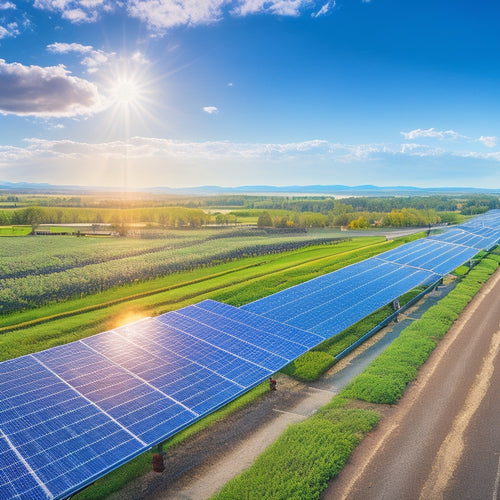
What to Consider for Solar Power Battery Systems Installation
Share
When installing solar power battery systems, you need to evaluate upfront costs, financing options, and potential incentives. Consider your energy storage requirements to determine the correct battery capacity, factoring in daily energy consumption and peak usage times. It is crucial to assess battery types for efficiency, lifespan, and maintenance needs. Additionally, think about how enhanced energy independence and backup power systems can safeguard against outages. By aligning your consumption patterns with solar generation, you can optimize performance and savings. Exploring these aspects deeply can lead you to a more informed decision on your energy storage solutions.
At a Glance
- Evaluate initial investment costs, including batteries, inverters, and installation, and explore financing options for affordability.
- Assess your energy needs to determine the appropriate battery capacity and ensure efficient energy storage.
- Consider the long-term savings potential from reduced energy bills and available solar incentives like tax credits and rebates.
- Ensure battery selection accounts for depth of discharge, round-trip efficiency, and maintenance requirements for optimal performance.
- Implement regular maintenance checks and monitor energy consumption to enhance battery lifespan and system efficiency.
Cost-Effective Energy Storage Solution
When considering a solar power battery system, you'll need to weigh the initial investment against the long-term savings potential.
Analyzing these costs can help you determine if this energy storage solution aligns with your financial goals.
Understanding the balance between upfront expenses and future savings is essential for making an informed decision.
Initial Investment Analysis
Investing in solar power battery systems can be a strategic move for homeowners seeking long-term energy savings. However, it's important to conduct a thorough initial investment analysis before diving into the installation process.
First, you'll need to evaluate the upfront costs associated with purchasing and installing the battery system. This includes the price of the batteries, inverters, and any additional equipment necessary for the setup.
Next, consider your financing options. Many homeowners opt for loans, leases, or power purchase agreements (PPAs) to make the initial investment more manageable. These options can help you spread the cost over time while still enjoying the benefits of energy independence.
It's vital to compare the terms and interest rates of different financing solutions to find the one that aligns with your financial situation.
Additionally, assess potential incentives or rebates from local or federal programs that could reduce your overall costs. By understanding the initial investment and exploring available financing options, you can make an informed decision that aligns with your goals for energy freedom and sustainability.
This analysis sets the foundation for a successful solar power battery system installation.
Long-Term Savings Potential
After evaluating the initial investment, understanding the long-term savings potential of solar power battery systems becomes crucial. Investing in these systems can markedly reduce your energy costs over time.
With rising electricity prices, your ability to store and use solar energy when needed grants you greater control over your expenses.
One key factor in your savings is the availability of solar incentives. Many regions offer tax credits, rebates, or other financial incentives that can lower your overall investment, enhancing your return on investment.
These incentives may vary, but taking advantage of them can expedite your path to savings.
Additionally, consider the maintenance costs associated with solar power battery systems. While they generally require minimal upkeep, it's wise to factor in any potential maintenance expenses when calculating your long-term savings.
A well-maintained system won't only prolong the lifespan of your batteries but also guarantee peak performance.
Ultimately, the combination of reduced energy bills, available solar incentives, and manageable maintenance costs positions solar power battery systems as a cost-effective energy storage solution.
Embracing this technology enables you to achieve greater energy independence and financial freedom.
Enhanced Energy Independence
Installing solar power battery systems markedly reduces your dependence on the grid, providing you with greater control over your energy sources.
This enhanced energy independence means you can rely on stored solar energy during outages, ensuring backup power assurance when you need it most.
By utilizing renewable energy, you not only enhance your resilience but also contribute to a sustainable future.
Additionally, implementing a solar power storage system can lead to long-term financial benefits and considerable savings compared to traditional energy sources.
Reduced Grid Dependence
Reducing grid dependence through solar power battery systems greatly improves your energy independence. By capturing solar energy and storing it for later use, you gain control over your electricity supply and reduce reliance on the traditional grid. This change not only enhances your energy resilience but also positions you to adapt to fluctuating energy demands and market conditions.
With solar battery systems, you can manage your energy consumption more effectively. You're no longer at the mercy of grid outages or price hikes; instead, you create your own energy ecosystem. This grid flexibility allows you to leverage stored energy during peak rates or outages, ensuring you always have power when you need it most.
Moreover, as you decrease your dependence on the grid, you contribute to a more sustainable energy environment. This shift encourages a sense of agency, allowing you to accept renewable energy solutions while minimizing your carbon footprint.
Ultimately, investing in solar power battery systems not only liberates you from energy constraints but also positions you as an advocate for a cleaner, more resilient future.
Backup Power Assurance
Backup power assurance provides peace of mind by guaranteeing that you have a dependable energy source even during unexpected outages.
By integrating a solar power battery system into your energy setup, you can enhance your energy independence, reducing your reliance on the grid. This system integration not only allows you to store excess solar energy but also permits you to draw on this stored power when the grid goes down.
However, achieving peak performance requires careful attention to maintenance considerations. Regular checks on battery health, connections, and software updates are essential to confirm your system operates smoothly.
You'll want to familiarize yourself with your battery management system, as it plays a vital role in maximizing your energy storage capacity and lifespan.
Investing in backup power isn't just about convenience; it's about taking control of your energy future.
By prioritizing reliable backup solutions, you enable yourself to maneuver through power interruptions without disruption.
With the right setup, you'll enjoy the freedom to live your life on your terms, knowing that you're equipped to handle whatever comes your way.
Battery Capacity and Lifespan
When evaluating your solar power battery system, understanding energy storage requirements is essential for maximizing efficiency.
Factors such as the battery type, whether lithium-ion or lead-acid, can influence your decision based on performance and cost.
Additionally, reflect on the advantages of lithium-ion batteries, which provide higher energy density and longer lifespans.
You'll also want to contemplate the expected lifespan of the batteries you choose, as this can greatly impact your overall investment.
Balancing these factors will help you make informed decisions for sustainable energy use.
Energy Storage Requirements
Understanding energy storage requirements is essential for optimizing solar power battery systems, as these factors directly influence both performance and longevity.
You'll want to assess your energy needs carefully, determining the appropriate battery capacity to meet your usage patterns. Consider how battery technology trends are advancing; advancements in lithium-ion and solid-state technologies offer higher efficiency and longer storage capabilities, enabling you to utilize solar energy more effectively.
As you investigate solar integration strategies, think about how to align your energy consumption with solar generation. This means evaluating peak usage times and ensuring your system can store enough energy to cover demand during non-sunny periods.
A well-calibrated battery system not only enhances your energy independence but also plays a key role in achieving sustainability goals.
Additionally, consider the depth of discharge (DoD) and round-trip efficiency when selecting your battery system. These factors influence how much usable energy you can extract from your battery and the overall effectiveness in storing solar energy.
Expected Battery Lifespan
Battery lifespan is an essential consideration that directly impacts the overall efficiency and cost-effectiveness of your solar power system. Typically, lithium-ion batteries, which are the most common type used in solar installations, last between 10 to 15 years. However, this lifespan can vary based on several factors, including how you maintain the battery and your usage patterns.
Proper battery maintenance is imperative for maximizing longevity. Regularly checking for corrosion, maintaining ideal temperature conditions, and keeping the battery charged within recommended limits can greatly extend its life.
You should also consider how you'll handle your battery at the end of its lifespan. Exploring recycling options is important, as it not only minimizes environmental impact but can also provide you with financial incentives. Many manufacturers offer programs to recycle their products, allowing you to contribute to a sustainable future while benefiting from potential rebates.
Ultimately, choosing the right battery and maintaining it effectively can guarantee you enjoy the freedom of reliable energy storage for years to come, while also being responsible stewards of the environment.
Selecting Based on Usage Patterns
When selecting a solar power battery system, it's essential to analyze your daily energy consumption and peak usage times.
Understanding these patterns helps you determine the right battery capacity to meet your needs efficiently.
Additionally, considering the energy efficiency and lifespan of various battery types, such as lithium-ion batteries, can further enhance your decision-making process.
Daily Energy Consumption
Many homeowners underestimate their daily energy consumption, which can greatly impact the effectiveness of a solar power battery system. Understanding your consumption patterns is essential for optimizing your solar setup. Energy monitoring tools can help you identify which devices consume the most power, allowing you to make informed decisions about battery capacity.
Here's a simplified breakdown to reflect upon:
| Device | Daily Usage (kWh) | Percentage of Total Usage (%) |
|---|---|---|
| Refrigerator | 1.5 | 25 |
| Lighting | 1.0 | 17 |
| Heating/Cooling | 2.0 | 33 |
| Electronics | 1.5 | 25 |
Peak Usage Times
Understanding your daily energy consumption sets the stage for analyzing peak usage times, which can greatly influence the performance of your solar power battery system. By identifying when your peak demand occurs, you can efficiently customize your battery system to guarantee ideal energy optimization.
Typically, peak usage times fall during the early morning and late afternoon when energy consumption spikes due to activities like cooking, heating, or cooling. Knowing these patterns allows you to strategically store energy generated during sunlight hours for use when demand surges.
When you align your solar battery system with these peak times, you not only maximize efficiency but also reduce reliance on the grid, enhancing your energy independence.
Additionally, this proactive approach can lead to significant savings over time by minimizing costly peak tariffs, enabling you to utilize your solar power potential fully.
In essence, understanding your peak usage times is central to making informed decisions about your solar power battery installation.
Higher Efficiency Than Traditional Systems
When comparing solar power battery systems to traditional energy storage solutions, you'll notice significant improvements in energy storage capacity.
These advanced systems can store more energy efficiently, allowing you to capture and employ solar power more effectively.
As a result, you'll experience lower energy costs and greater energy independence.
Improved Energy Storage Capacity
Solar power battery systems have revolutionized energy storage by remarkably enhancing efficiency compared to traditional systems. With battery technology advancements, these systems now offer improved energy storage capacity that allows you to maximize your solar investment.
Unlike older technologies, modern batteries are designed to store more energy with less waste, translating into lower costs and increased freedom from reliance on the grid.
You'll find that energy management systems play an essential role in this improvement. They optimize the way energy is stored and employed, ensuring that you make the most of every kilowatt-hour produced.
These smart systems monitor energy usage patterns and adjust charging and discharging processes accordingly, which greatly elevates efficiency.
Frequently Asked Questions
What Maintenance Is Required for Solar Power Battery Systems?
You need to monitor your solar power battery systems regularly. Check the battery lifespan and guarantee ideal charging cycles. Clean terminals and connections to prevent corrosion, promoting efficiency and extending overall performance for your energy independence.
Are There Any Warranties for Solar Battery Systems?
Like a safety net, warranties for solar battery systems can protect your investment. They often cover battery lifespan and installation costs, ensuring you're not left in the dark if issues arise during usage.
How Do Weather Conditions Affect Battery Performance?
Weather conditions greatly affect battery performance. Extreme temperatures can decrease efficiency, while high humidity impacts moisture absorption. Understanding these temperature effects and humidity impact helps you optimize your solar power system for reliable energy production.
Can Solar Batteries Be Recycled After Their Lifespan?
Yes, solar batteries can be recycled after their lifespan. Recycling processes help minimize environmental impact by recovering precious materials, reducing waste, and promoting sustainability, ensuring you contribute positively to the planet while maximizing resource efficiency.
What Permits Are Needed for Battery Installation?
You'd think installing a battery would be simple, but local regulations often complicate things. Research your area's permits, as these can affect installation costs considerably. Ignoring them could lead to unexpected delays and expenses.
Explore More
In the modern era, installing a solar power battery system isn't just a smart choice; it's like revealing the secret vault to unlimited energy freedom! By investing wisely, you'll not only save a fortune but also gain energy independence that makes you feel like a superhero. With the right battery capacity customized to your needs, you'll experience efficiency levels that could put traditional systems to shame. Don't miss out on changing your energy future—take the leap into sustainable power today!
Related Posts
-

Sustainable and Eco-Friendly Generators for a Reduced Carbon Footprint
Sustainable and eco-friendly generators are perfect for cutting your carbon footprint and increasing energy efficienc...
-

Top 10 Off Grid Camping Gear Must-Haves
When you're off-grid camping, the right gear is crucial for a smooth expedition. Start with a durable, weather-resist...
-

Applications of Photovoltaic Systems
Photovoltaic systems are versatile, converting sunlight into electricity for various applications. You can use them i...


